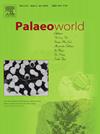Phylogenetic evolution of Neorotalia mecatepecensis to Miogypsinidae from Rajamandala Formation, West Java, Indonesia
IF 1.7
3区 地球科学
Q2 PALEONTOLOGY
引用次数: 0
Abstract
At Tagogapu in West Java, the Miogypsinidae larger benthic foraminifera from the Rajamandala Limestone have been studied for biometric trends in evolution. Observed taxa include Neorotalia mecatepecensis, Paleomiogypsina sp., Miogypsinella bornea, Miogypsinoides complanatus, and Miogypsinoides formosensis, with biometric parameters (X, Y, Z, AX, and γ) revealing distinct phylogenetic trends through heterochrony. Neorotalia mecatepecensis morphotype A is identified as the basal species, while Neorotalia mecatepecensis morphotype B diverges through nepionic retardation. The transition to Paleomiogypsina sp. is marked by the development of auxiliary chambers. The transition to Miogypsinella bornea is suggested by the addition of secondary foramen and more auxiliary chambers. The evolution to Miogypsinoides complanatus is characterized by the planispiral nepionic, loss of an apertural lip, and broader auxiliary chamber arrangements. The speciation of Miogypsinoides formosensis is recognized by the peramorphic addition of late adult stage auxiliary chambers. Biostratigraphic analysis and strontium isotopic dating place the studied taxa within the Te 2-3 to Te 4 Letter Stage (late Oligocene). This research highlights the biostratigraphic application of biometric methods in a lineage with heterochronous evolutionary trends, and proposes AX as a robust metric for the descendant peramorphic forms.
印度尼西亚西爪哇Rajamandala组mecatepecneorotalia meatepecensis至Miogypsinidae的系统进化
在西爪哇的Tagogapu,研究了来自Rajamandala石灰岩的Miogypsinidae大型底栖有孔虫的生物特征进化趋势。观察到的分类群包括Neorotalia mecatepecensis、Paleomiogypsina sp.、Miogypsinella bornea、miogypsinides planatus和miogypsinides formosensis,其生物特征参数(X、Y、Z、AX和γ)通过异时性揭示了不同的系统发育趋势。Neorotalia mecatepecensis形态型A被确定为基种,而Neorotalia mecatepecensis形态型B通过nepionic迟滞分化。向Paleomiogypsina sp.过渡的标志是辅助室的发育。通过增加次级孔和更多的辅助腔室,提示向密氏肺菌过渡。向平腹小齿进化的特征是平螺旋形的唇形,失去开口唇形,辅助腔室布置更宽。台湾miogypsinides formosensis的形态是由成虫后期辅助腔的变质性添加来识别的。生物地层分析和锶同位素定年将研究类群确定在晚渐新世的第2-3 ~第4字母阶段。本研究强调了生物测量方法在具有异时进化趋势的谱系中的生物地层学应用,并提出AX作为后代变质岩形式的稳健度量。
本文章由计算机程序翻译,如有差异,请以英文原文为准。
求助全文
约1分钟内获得全文
求助全文
来源期刊

Palaeoworld
PALEONTOLOGY-
CiteScore
4.00
自引率
5.90%
发文量
95
期刊介绍:
Palaeoworld is a peer-reviewed quarterly journal dedicated to the study of past life and its environment. We encourage submission of original manuscripts on all aspects of palaeontology and stratigraphy, comparisons of regional and global data in time and space, and results generated by interdisciplinary investigations in related fields. Some issues will be devoted entirely to a special theme whereas others will be composed of contributed articles. Palaeoworld is dedicated to serving a broad spectrum of geoscientists and palaeobiologists as well as serving as a resource for students in fields as diverse as palaeobiology, evolutionary biology, taxonomy and phylogeny, geobiology, historical geology, and palaeoenvironment.
Palaeoworld publishes original articles in the following areas:
•Phylogeny and taxonomic studies of all fossil groups
•Biostratigraphy, chemostratigraphy, chronostratigraphy
•Palaeoecology, palaeoenvironment and global changes throughout Earth history
•Tempo and mode of biological evolution
•Biological events in Earth history (e.g., extinctions, radiations)
•Ecosystem evolution
•Geobiology and molecular palaeobiology
•Palaeontological and stratigraphic methods
•Interdisciplinary studies focusing on fossils and strata
 求助内容:
求助内容: 应助结果提醒方式:
应助结果提醒方式:


